2013 SMART FORTWO COUPE ELECTRIC DRIVE battery
[x] Cancel search: batteryPage 97 of 218
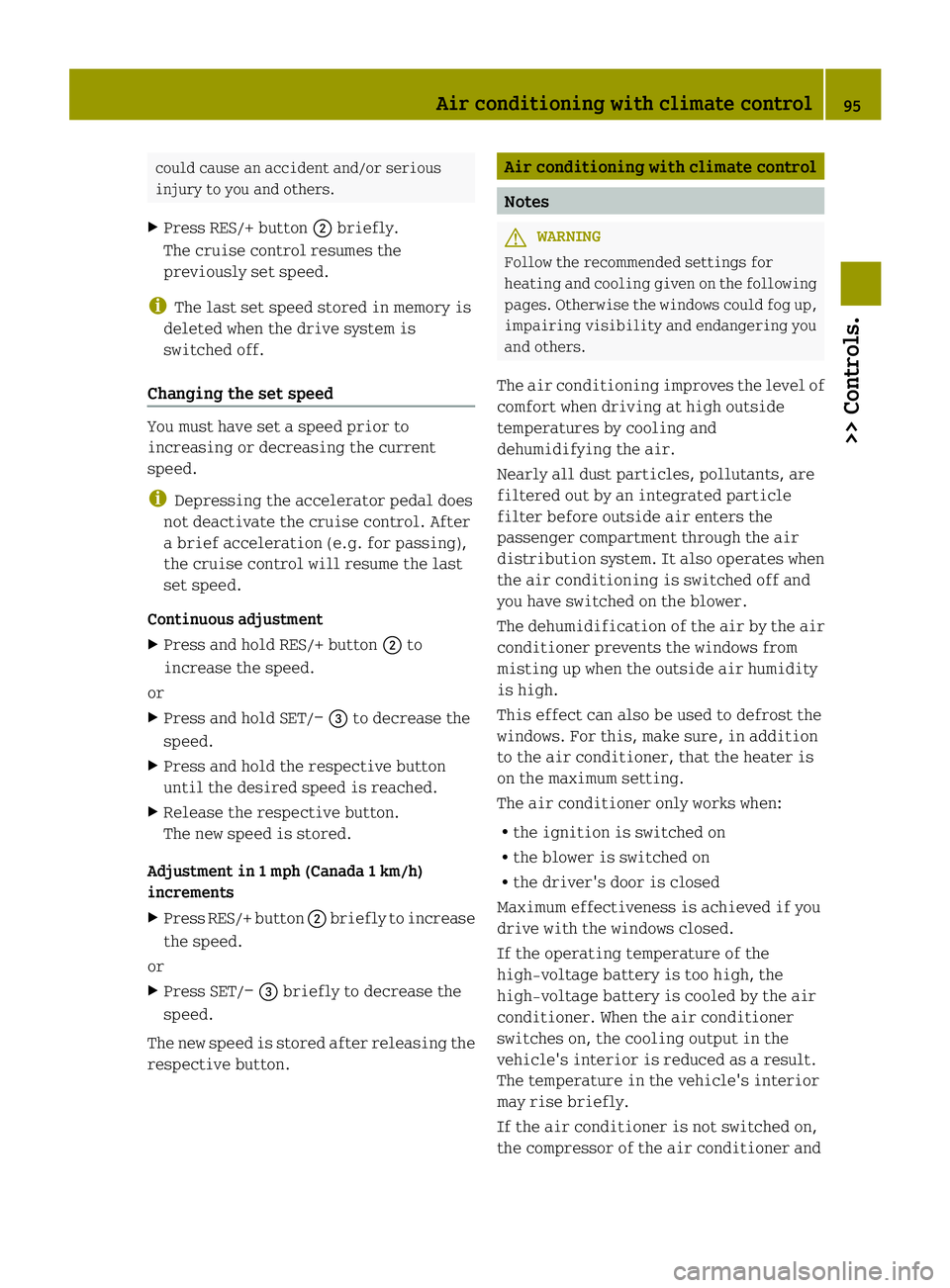
could cause an accident and/or serious
injury to you and others.
X Press RES/+ button 0003briefly.
The cruise control resumes the
previously set speed.
i The last set speed stored in memory is
deleted when the drive system is
switched off.
Changing the set speed You must have set a speed prior to
increasing or decreasing the current
speed.
i
Depressing the accelerator pedal does
not deactivate the cruise control. After
a brief acceleration (e.g. for passing),
the cruise control will resume the last
set speed.
Continuous adjustment
X Press and hold RES/+ button 0003to
increase the speed.
or
X Press and hold SET/− 002Bto decrease the
speed.
X Press and hold the respective button
until the desired speed is reached.
X Release the respective button.
The new speed is stored.
Adjustment in 1 mph (Canada 1 km/h)
increments
X Press RES/+ button 0003briefly to increase
the speed.
or
X Press SET/− 002Bbriefly to decrease the
speed.
The new speed is stored after releasing the
respective button. Air conditioning with climatec
ontrol Notes
G
WARNING
Follow the recommended settings for
heating and cooling given on the following
pages .Otherwise the windows could fog up,
impairing visibility and endangering you
and others.
The air conditionin gimproves the leve lof
comfort when driving at high outside
temperatures by cooling and
dehumidifying the air.
Nearly all dust particles, pollutants, are
filtered out by an integrated particle
filter before outside air enters the
passenger compartment through the air
distribution system .It also operates when
the air conditioning is switched off and
you have switched on the blower.
The dehumidification of the air by the air
conditioner prevents the windows from
misting up when the outside air humidity
is high.
This effect can also be used to defrost the
windows. For this, make sure, in addition
to the air conditioner, that the heater is
on the maximum setting.
The air conditioner only works when:
R the ignition is switched on
R the blower is switched on
R the driver's door is closed
Maximum effectiveness is achieved if you
drive with the windows closed.
If the operating temperature of the
high‑voltage battery is too high, the
high‑voltage battery is cooled by the air
conditioner. When the air conditioner
switches on, the cooling output in the
vehicle's interior is reduced as a result.
The temperature in the vehicle's interior
may rise briefly.
If the air conditioner is not switched on,
the compressor of the air conditioner and Air conditioning with climate control
95>> Controls. Z
Page 98 of 218
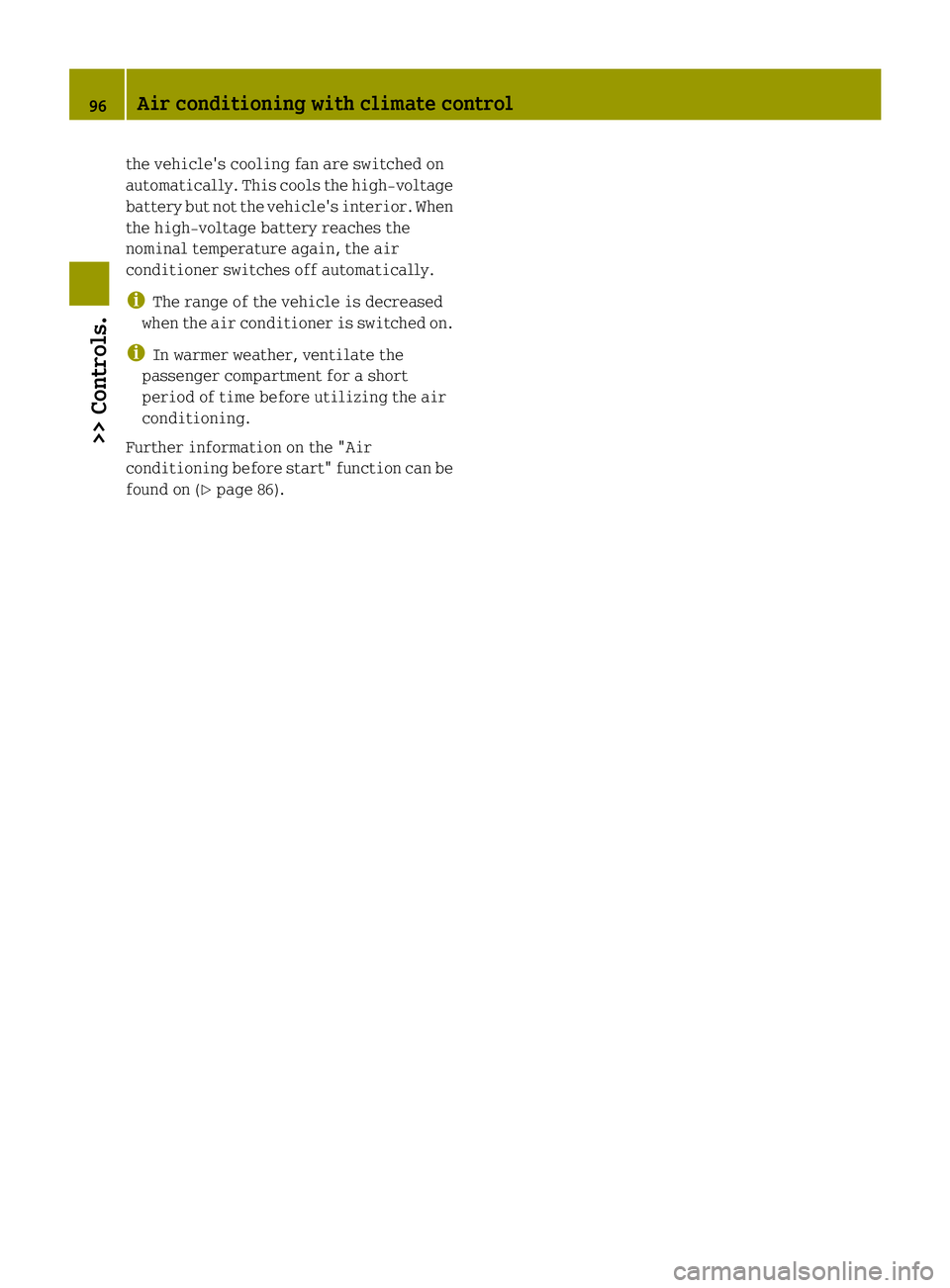
the vehicle's cooling fan are switched on
automatically. This cools the high‑voltage
battery but not the vehicle's interior .When
the high‑voltage battery reaches the
nominal temperature again, the air
conditioner switches off automatically.
i The range of the vehicle is decreased
when the air conditioner is switched on.
i In warmer weather, ventilate the
passenger compartment for a short
period of time before utilizing the air
conditioning.
Further information on the "Air
conditioning before start" function can be
found on (Y page 86).96
Air conditioning with climate control>> Controls.
Page 101 of 218
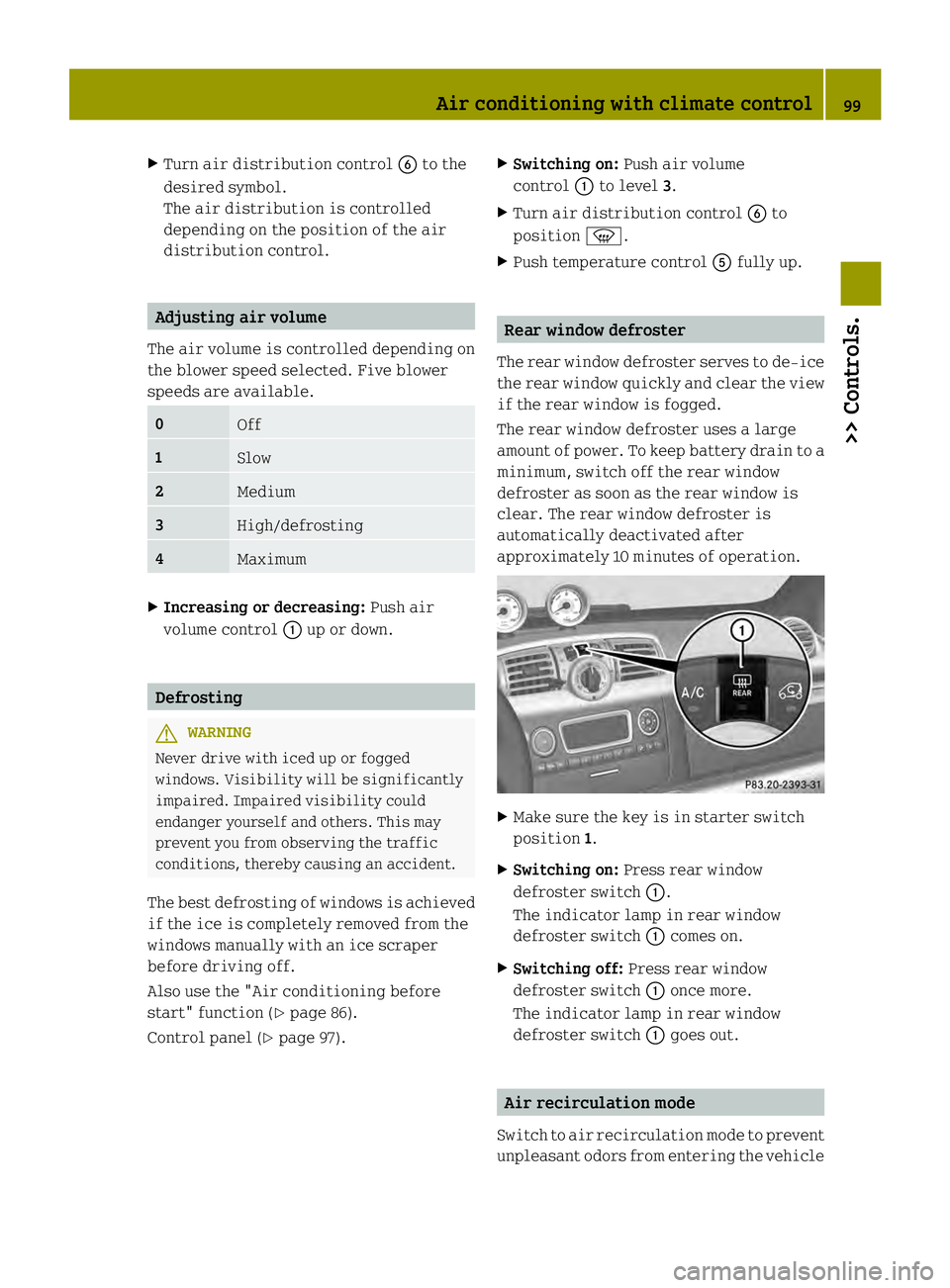
X
Turn air distribution control 0029to the
desired symbol.
The air distribution is controlled
depending on the position of the air
distribution control. Adjusting air volume
The air volume is controlled depending on
the blower speed selected. Five blower
speeds are available. 0
Off
1
Slow
2
Medium
3
High/defrosting
4
Maximum
X
Increasing or decreasing: Push air
volume control 0002up or down. Defrosting
G
WARNING
Never drive with iced up or fogged
windows. Visibility will be significantly
impaired. Impaired visibility could
endanger yourself and others. This may
prevent you from observing the traffic
conditions, thereby causing an accident.
The best defrosting of windows is achieved
if the ice is completely removed from the
windows manually with an ice scraper
before driving off.
Also use the "Air conditioning before
start" function (Y page 86).
Control panel (Y page 97). X
Switching on: Push air volume
control 0002to level 3.
X Turn air distribution control 0029to
position 0006.
X Push temperature control 0028fully up. Rear window defroster
The rear window defroster serves to de-ice
the rear window quickly and clear the view
if the rear window is fogged.
The rear window defroster uses a large
amount of power. To keep battery drain to a
minimum, switch off the rear window
defroster as soon as the rear window is
clear. The rear window defroster is
automatically deactivated after
approximately 10 minutes of operation. X
Make sure the key is in starter switch
position 1.
X Switching on: Press rear window
defroster switch 0002.
The indicator lamp in rear window
defroster switch 0002comes on.
X Switching off: Press rear window
defroster switch 0002once more.
The indicator lamp in rear window
defroster switch 0002goes out. Air recirculation mode
Switch to air recirculation mode to prevent
unpleasant odors from entering the vehicle Air conditioning with climate control
99>> Controls. Z
Page 108 of 218
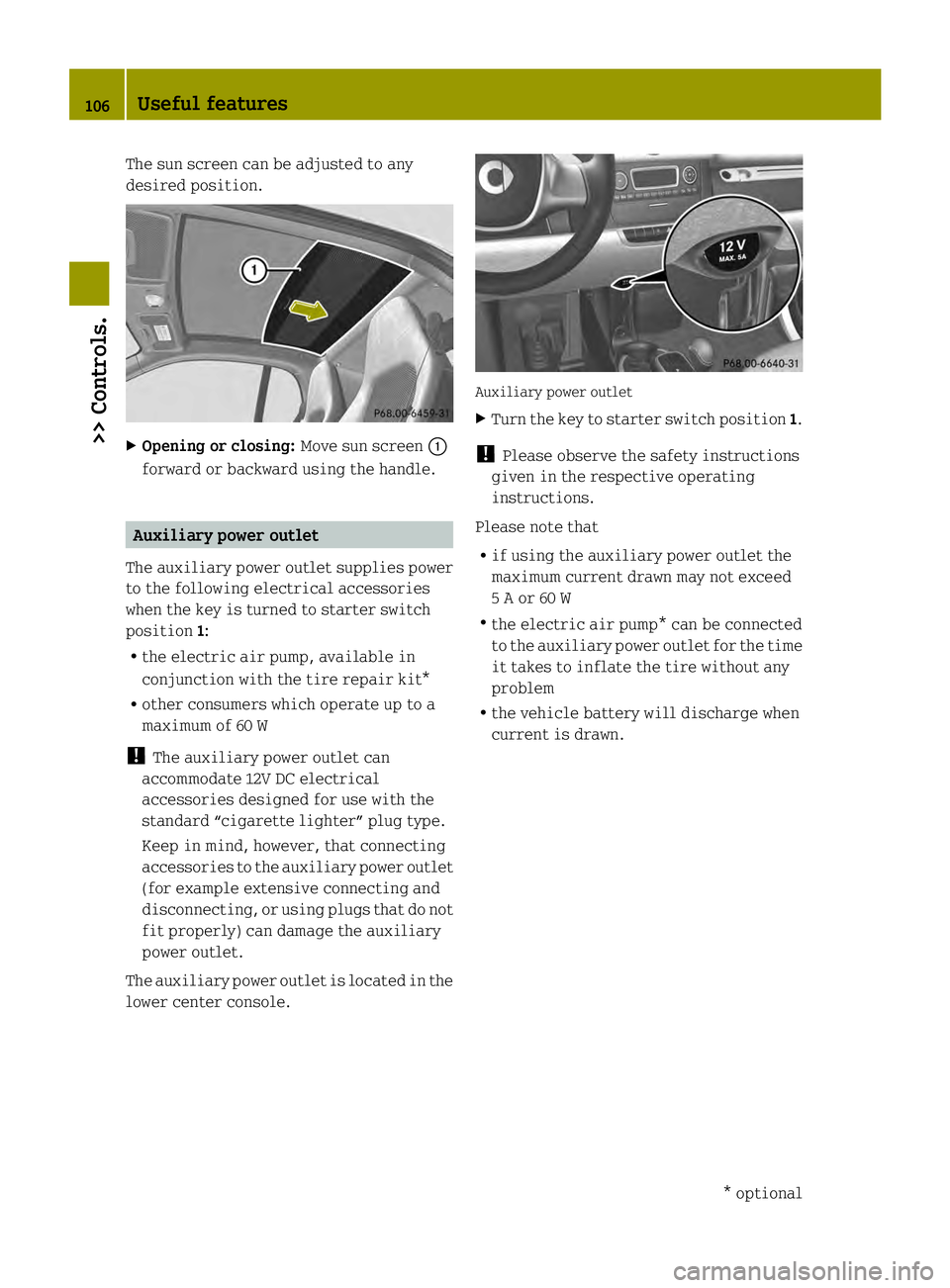
The sun screen can be adjusted to any
desired position.
X
Opening or closing: Move sun screen0002
forward or backward using the handle. Auxiliary power outlet
The auxiliary power outlet supplies power
to the following electrical accessories
when the key is turned to starter switch
position 1:
R the electric air pump, available in
conjunction with the tire repair kit*
R other consumers which operate up to a
maximum of 60 W
! The auxiliary power outlet can
accommodate 12V DC electrical
accessories designed for use with the
standard “cigarette lighter” plug type.
Keep in mind, however, that connecting
accessories to the auxiliary power outlet
(for example extensive connecting and
disconnecting, or using plugs that do not
fit properly) can damage the auxiliary
power outlet.
The auxiliary power outlet is located in the
lower center console. Auxiliary power outlet
X
Turn the key to starter switch position 1.
! Please observe the safety instructions
given in the respective operating
instructions.
Please note that
R if using the auxiliary power outlet the
maximum current drawn may not exceed
5 A or 60 W
R the electric air pump* can be connected
to the auxiliary power outlet for the time
it takes to inflate the tire without any
problem
R the vehicle battery will discharge when
current is drawn. 106
Useful features>> Controls.
* optional
Page 109 of 218
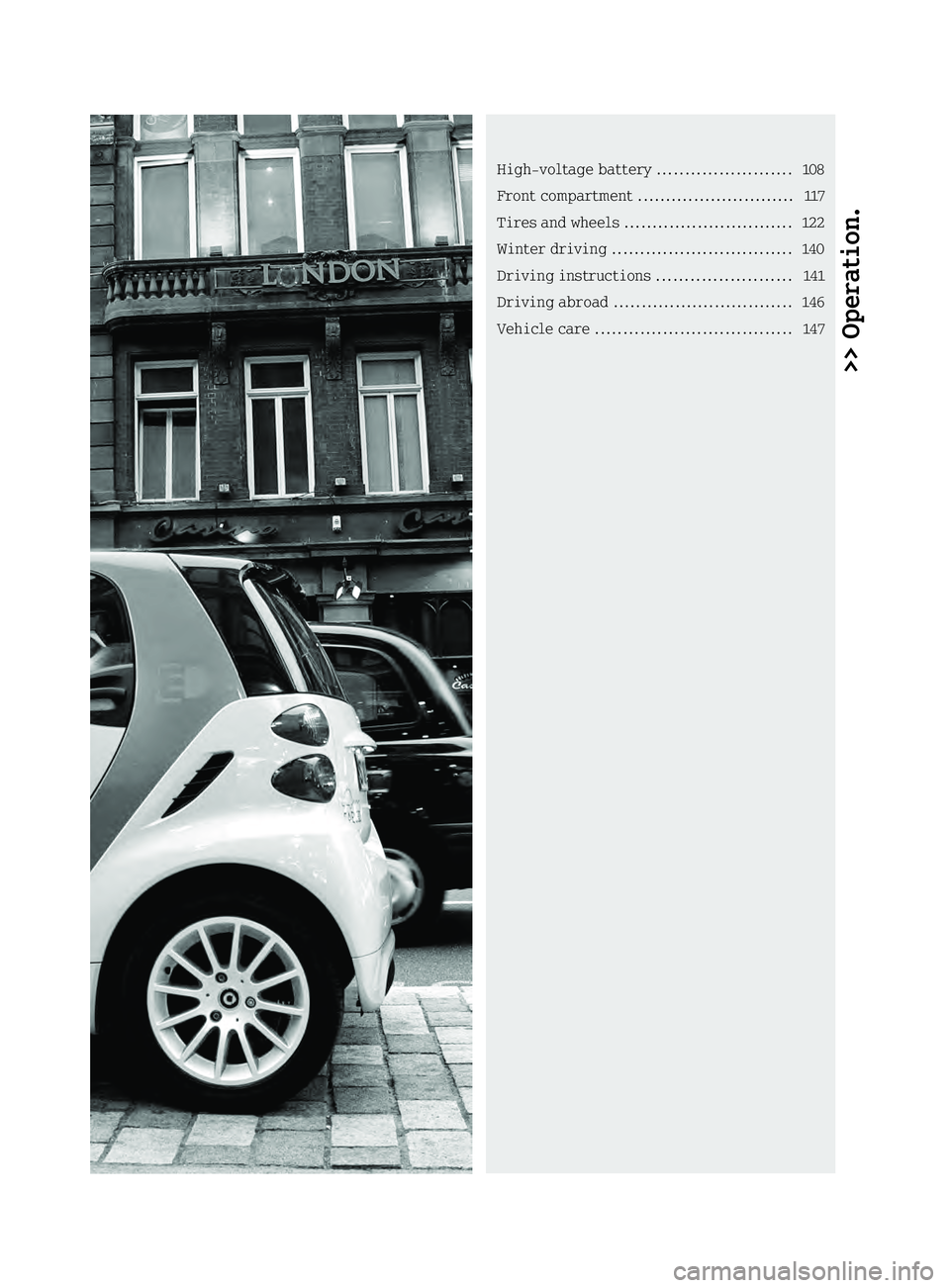
>> Operation.High-voltage battery
........................108
Front compartment ............................ 117
Tires and wheel s.............................. 122
Winte rdriving ................................ 140
Driving instructions ........................141
Driving abroad ................................ 146
Vehicle care ................................... 147
Page 110 of 218
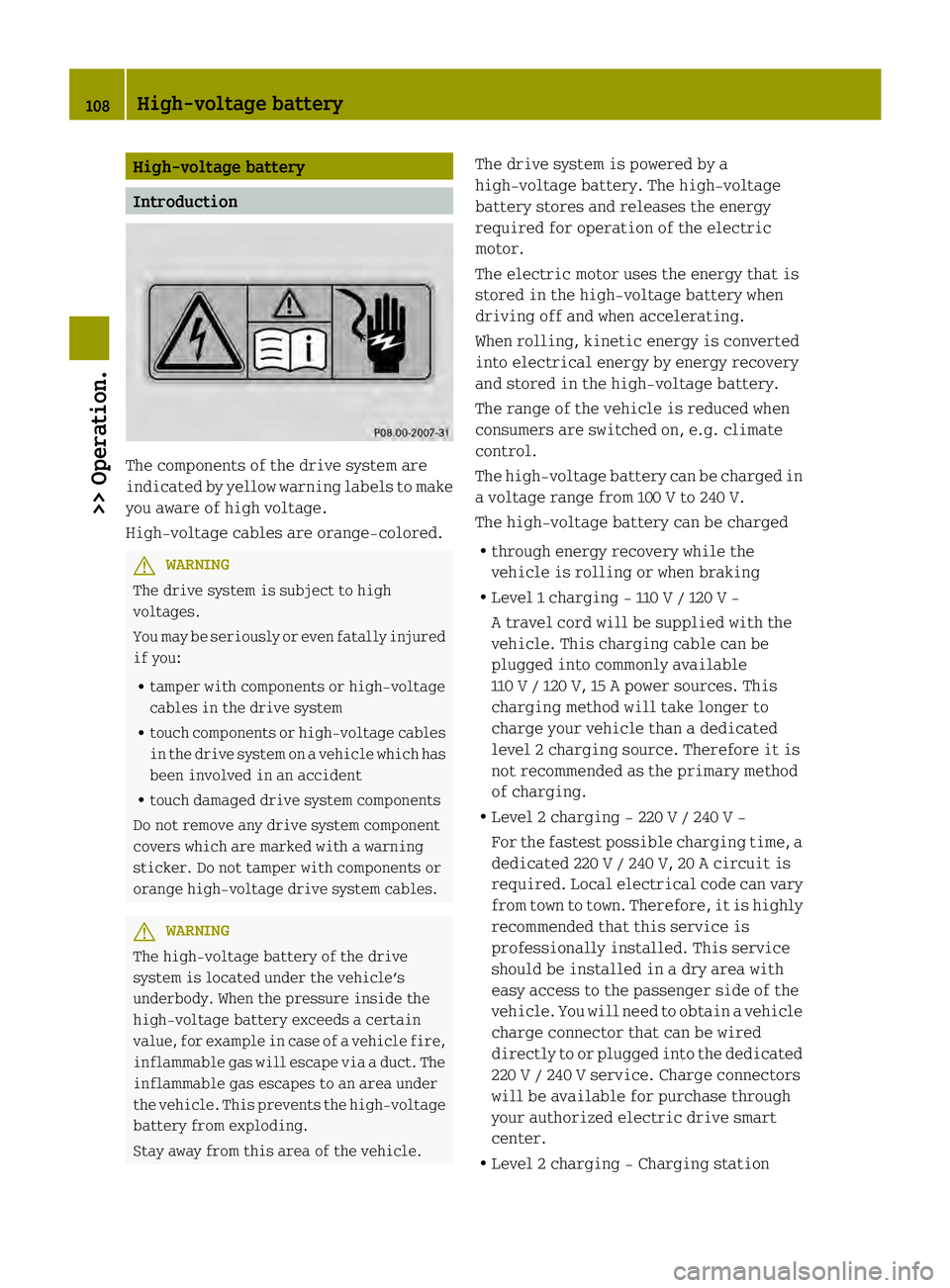
High-voltage battery
Introduction
The components of the drive system are
indicated by yellow warning labels to make
you aware of high voltage.
High‑voltage cablesa
re orange‑colored.G
WARNING
The drive system is subject to high
voltages.
You may be seriously or even fatally injured
if you:
R tamper with components or high-voltage
cables in the drive system
R touch components or high-voltage cables
in the drive system on avehicle which has
been involved in an accident
R touch damaged drive system components
Do not remove any drive system component
covers which are marked with a warning
sticker. Do not tamper with components or
orange high-voltage drive system cables. G
WARNING
The high‑voltage battery of the drive
system is located under the vehicle’s
underbody. When the pressure inside the
high‑voltage battery exceeds a certain
value, for example in case of avehicle fire,
inflammable gas will escape via a duct. The
inflammable gas escapes to an area under
the vehicle. This prevents the high‑voltage
battery from exploding.
Stay away from this area of the vehicle. The drive system is powered by a
high‑voltage battery. The high‑voltage
battery stores and releases the energy
required for operation of the electric
motor.
The electric motor uses the energy that is
stored in the high‑voltage battery when
driving off and when accelerating.
When rolling, kinetic energy is converted
into electrical energy by energy recovery
and stored in the high‑voltage battery.
The range of the vehicle is reduced when
consumers are switched on, e.g. climate
control.
The high‑voltage battery can be charged in
a voltage range from 100 V to 240 V.
The high‑voltage battery can be charged
R through energy recovery while the
vehicle is rolling or when braking
R Level 1 charging - 110 V / 120 V -
A travel cord will be supplied with the
vehicle. This charging cable can be
plugged into commonly available
110 V / 120 V, 15 A power sources. This
charging method will take longer to
charge your vehicle than adedicated
level 2 charging source. Therefore it is
not recommended as the primary method
of charging.
R Level 2 charging - 220 V / 240 V -
For the fastest possible charging time, a
dedicated 220 V /240 V, 20 A circuit is
required. Local electrical code can vary
from town to town. Therefore, it is highly
recommended that this service is
professionally installed. This service
should be installed in a dry area with
easy access to the passenger side of the
vehicle. You will need to obtain avehicle
charge connector that can be wired
directly to or plugged into the dedicated
220 V / 240 V service. Charge connectors
will be available for purchase through
your authorized electric drive smart
center.
R Level 2 charging - Charging station 108
High-voltage battery>> Operation.
Page 111 of 218

Use only charging cables which have been
approved and recommended for the vehicle.
Do not use:
R extension chords
R cable reels
R multiple sockets
R travel adapters
i When possible, only charge the
high‑voltage battery when the charge
level is below 80 %.
It is recommended to charge the
high‑voltage battery prior to reaching
less than 20% state of charge.
Discharged high‑voltage battery When the high‑voltage battery is
completely discharged, the drive system is
switched off. This protects the battery
from exhaustive discharge.
i By switching the ignition off and on
again, the drive system can be briefly
reactivate donce. This allows you to park
the vehicle safely.
Do not allow your vehicle to remain
stationary for more than 14 days with a
discharged, or nearly discharged,
high‑voltage battery. You can check the
charge level with the charge level gauge
(Y page 79).
High or low outside temperatures The efficiency of the high‑voltage battery
is temperature-dependent and decreases
at high or low temperatures .Additionally,
the electrolytes used can gel at very low
temperatures.
You can check the maximum capacity
available using the indicator in the
multifunction display (Y page 83).Energy consumption and range The available energy of the high‑voltage
battery is reduced by:
R
low outside temperatures
R switching on electrical consumers
At low temperatures and after being parked
for an extended period without charging,
the physical properties of the
high‑voltage battery:
R can cause a significant reductio ninthe
performance of the battery
R can lead to longer charging times
In extreme cases, you will not be able to
start the vehicle. For this reason, always
connect the charging cable or make sure the
battery is completely charged when
parking the vehicle in low outside
temperatures or for an extended period of
time.
Due to its physical properties, the
capacity of a high‑voltage battery
decreases over its lifespan.
Thus, the following are reduced:
R the maximum attainable range of the
vehicle
R the maximum performance output
(acceleration) of the vehicle
You can actively contribute to the
reduction of the vehicle's energy
consumption by:
R driving conservatively
R maintaining the vehicle regularly
R decreasing the use of electrical
consumers
Notes on battery care Avoid storing and transporting the vehicle
at high temperatures for extended periods
of time (e. g. container transport).
When out of use for longer periods of time,
connect the vehicle to a voltage supply.
If the vehicle is not connected to
avoltage
supply, it must remain within a High-voltage battery
109>> Operation. Z
Page 112 of 218
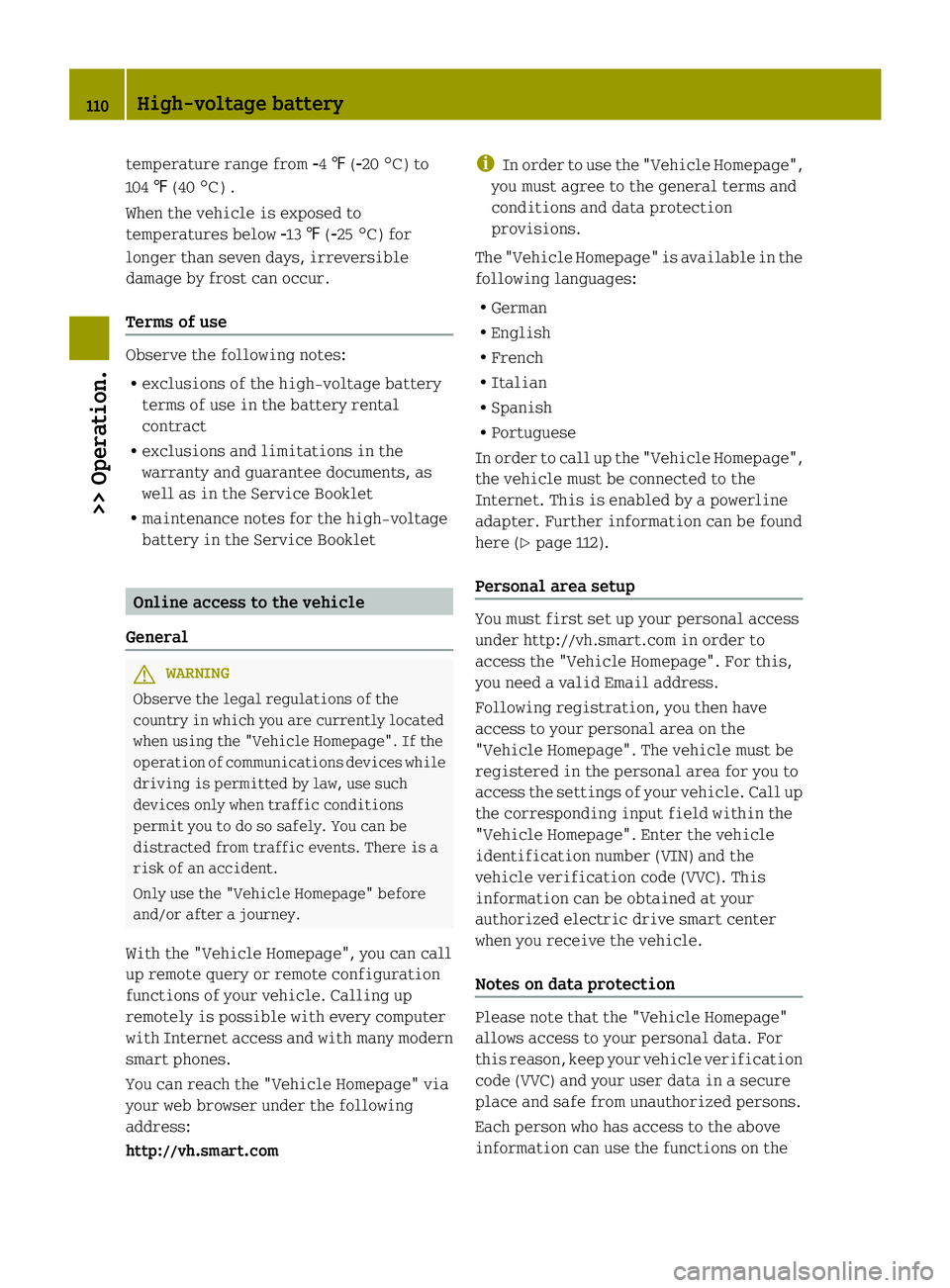
temperature range from
00324‡(003220 ¥) to
104 ‡(40 ¥) .
When the vehicle is exposed to
temperatures below 003213‡(003225 ¥) for
longer than seven days, irreversible
damage by frost can occur.
Terms of use Observe the following notes:
R
exclusions of the high‑voltage battery
terms of use in the battery rental
contract
R exclusions and limitations in the
warranty and guarantee documents, as
well as in the Service Booklet
R maintenance notes for the high‑voltage
battery in the Service Booklet Online access to the vehicle
General G
WARNING
Observe the legal regulations of the
country in which you are currently located
when using the "Vehicle Homepage". If the
operation of communications devices while
driving is permitted by law, use such
devices only when traffic conditions
permit you to do so safely. You can be
distracted from traffic events. There is a
risk of an accident.
Only use the "Vehicle Homepage" before
and/or after a journey.
With the "Vehicle Homepage", you can call
up remote query or remote configuration
functions of your vehicle. Calling up
remotely is possible with every computer
with Internet access and with many modern
smart phones.
You can reach the "Vehicle Homepage" via
your web browser under the following
address:
http://vh.smart.com i
In order to use the "Vehicle Homepage",
you must agree to the general terms and
conditions and data protection
provisions.
The "Vehicle Homepage" is available in the
following languages:
R German
R English
R French
R Italian
R Spanish
R Portuguese
In order to call up the "Vehicle Homepage",
the vehicle must be connected to the
Internet. This is enabled by a powerline
adapter. Further information can be found
here (Y page 112).
Personal area setup You must first set up your personal access
under http://vh.smart.com in order to
access the "Vehicle Homepage". For this,
you need a valid Email address.
Following registration, you then have
access to your personal area on the
"Vehicle Homepage". The vehicle must be
registered in the personal area for you to
access the setting sofyour vehicle. Call up
the corresponding input field within the
"Vehicle Homepage". Enter the vehicle
identification number (VIN) and the
vehicle verification code (VVC). This
information can be obtained at your
authorized electric drive smart center
when you receive the vehicle.
Notes on data protection Please note that the "Vehicle Homepage"
allows access to your personal data. For
this reason, keep your vehicle verification
code (VVC) and your user data in a secure
place and safe from unauthorized persons.
Each person who has access to the above
information can use the functions on the110
High-voltage battery>> Operation.